“A Time to Dance” movie cast features a vibrant ensemble that brings the compelling story to life through movement and emotion; ten-dance.com celebrates their artistry. Discover the magic behind the performances, explore the dancers’ backgrounds, and delve into their dedication to the art of dance. Understand more about the world of dance.
1. Who Were the Original Dancers in “Encore” and What Are They Doing Now?
The original dancers in Daniel Gwirtzman Dance Company’s “Encore” each brought unique talents and experiences to the production. Many have continued to excel in dance and related fields, while others have transitioned to different careers, all while maintaining a deep connection to the arts.
1.1. Cary McWilliam: From the Stage to the Classroom
Cary McWilliam, a longtime company member from 1998 to 2008, played the role of the Costumer in the original production of “Encore.”
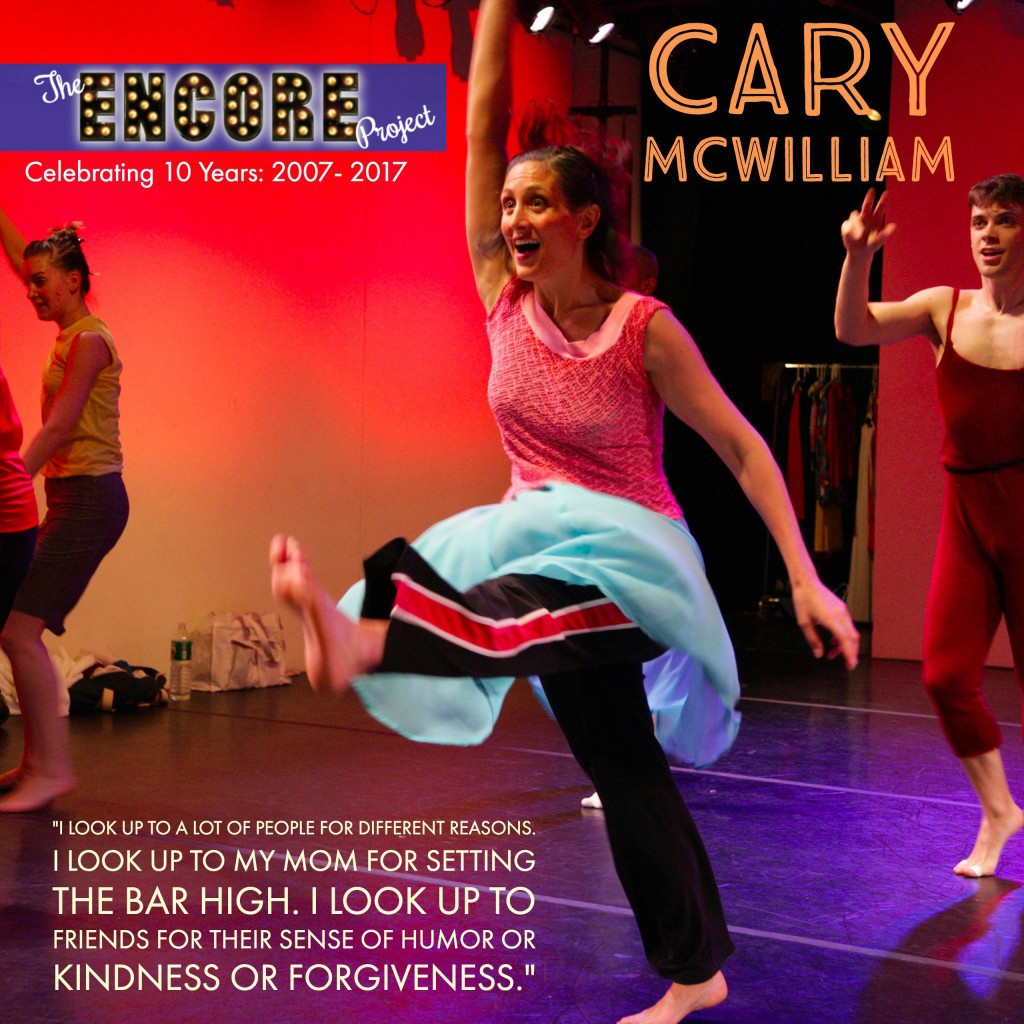 Cary McWilliam, Original Encore Dancer, Guilty Pleasure is Pizza Party Movie Night
Cary McWilliam, Original Encore Dancer, Guilty Pleasure is Pizza Party Movie Night
Cary’s Reflections:
- Creative Process: Cary recalls the challenge of the dance’s speed and the intricate backstage choreography required for quick costume changes. She imagined how interesting it would be for the audience to witness this behind-the-scenes action.
- Advice to Dancers: She echoes her former professor’s advice to “Crosstrain” and emphasizes the benefits of swimming for dancers.
- Current Activities: Although no longer dancing professionally, Cary teaches with The Joyce Theater and the Center for Arts Education.
- Favorite Dance Style: Modern dance remains her favorite due to its variety and constant surprises.
Additional Insights:
- Cary’s experience highlights the physical demands and intricate coordination involved in dance productions.
- Her transition to teaching reflects a commitment to passing on her knowledge and passion to the next generation of dancers.
1.2. Christian von Howard: A Multifaceted Career in Dance Education and Performance
Christian von Howard played an integral role in the early development of “Encore” and served as Daniel’s assistant on several occasions.
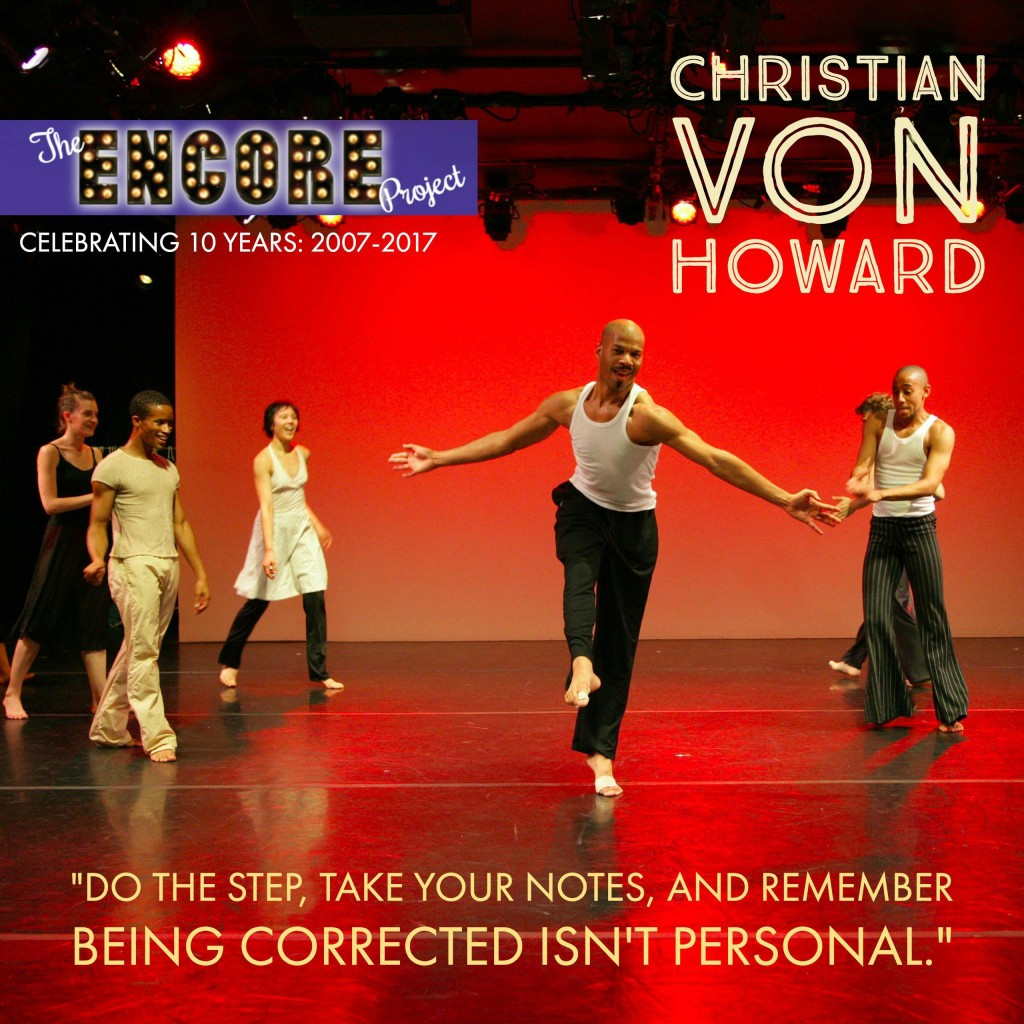 Christian von Howard, Original Encore Dancer, Keeps Coloring Pencils In His Dance Bag
Christian von Howard, Original Encore Dancer, Keeps Coloring Pencils In His Dance Bag
Christian’s Reflections:
- Creative Process: He cherished performing the work in Michigan with Daniel, Stacy, and Jamie.
- Advice to Dancers: Christian emphasizes professionalism, preparation, research, and immersion in other arts, stressing the importance of taking corrections constructively.
- Current Activities: He teaches at Montclair State University and The Ailey School, and directs the VON HOWARD PROJECT.
- Favorite Dance Style: Christian believes that “dance is dance” and doesn’t favor one style over another.
Additional Insights:
- Christian’s multifaceted career demonstrates the diverse opportunities available to dancers, including teaching, choreography, and artistic direction.
- His emphasis on professionalism and continuous learning underscores the dedication required to succeed in the dance world.
1.3. Madeline Hoak: From Dance to Aerial Acrobatics
Madeline Hoak found the creation process of “Encore” challenging yet exhilarating, especially as she was returning to dance after a year-long break.
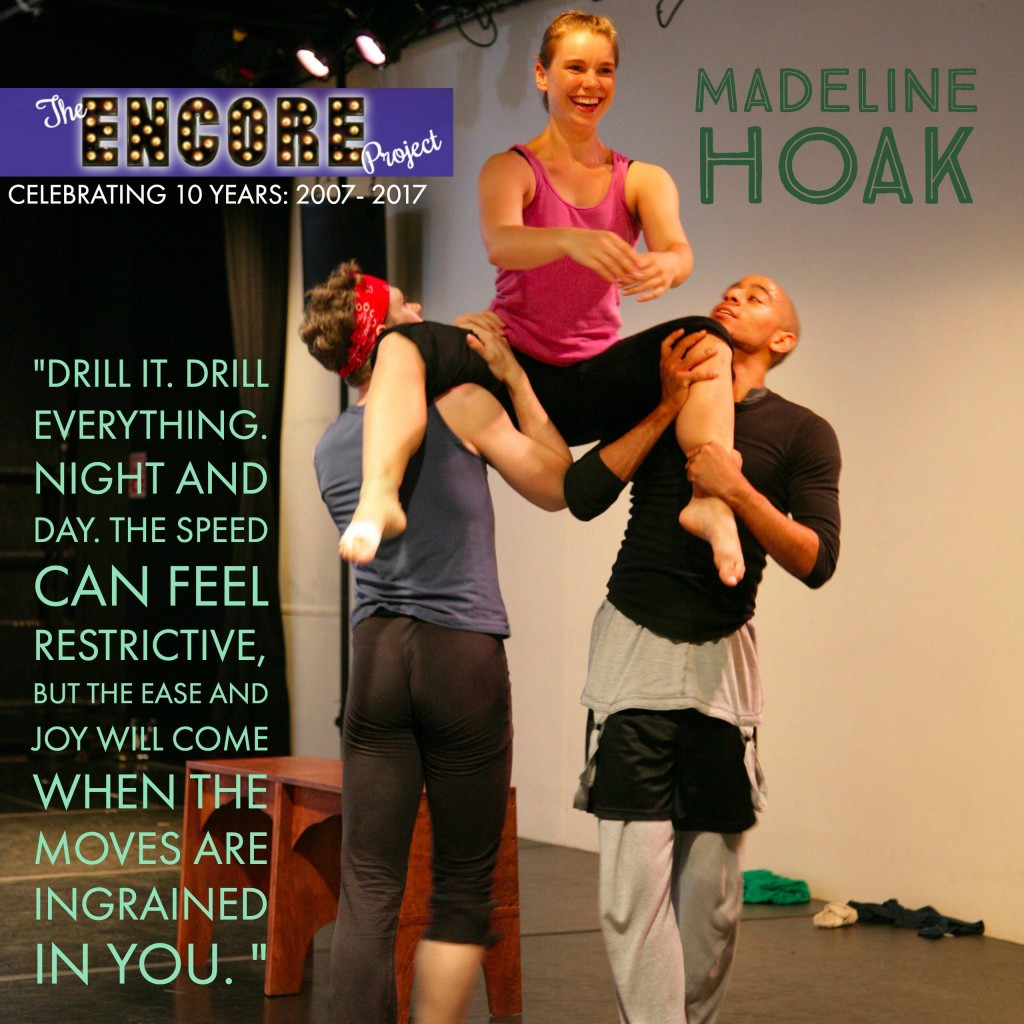 Madeline Hoak, Original Encore Dancer, Spirit Animal is a Pigmy Marmoset
Madeline Hoak, Original Encore Dancer, Spirit Animal is a Pigmy Marmoset
Madeline’s Reflections:
- Favorite Memory: She loved performing “Congo” with Michael and found the improv section with the hat to feel natural and effortless.
- Advice to Dancers: Madeline advises dancers to “Drill it,” emphasizing the importance of repetition to ingrain moves and achieve ease and joy in performance.
- Current Activities: Madeline transitioned to a full-time circus career in 2013 and now teaches Aerial Acrobatics at Muhlenberg College and Pace University. She also crafts lectures and courses on traditional American circus history.
- Favorite Dance Style: She is mesmerized by tango and flamenco, appreciating their deep sensuality and emotion.
Additional Insights:
- Madeline’s career path illustrates the adaptability and versatility of dancers, as she successfully transitioned from dance to aerial acrobatics.
- Her passion for circus history showcases the diverse interests and intellectual pursuits of dancers.
1.4. Stacy Martorana: From the Stage to Yoga and Beyond
Stacy Martorana’s experience with “Encore” marked her first professional dance job after graduating from the University of the North Carolina School of the Arts in 2006.
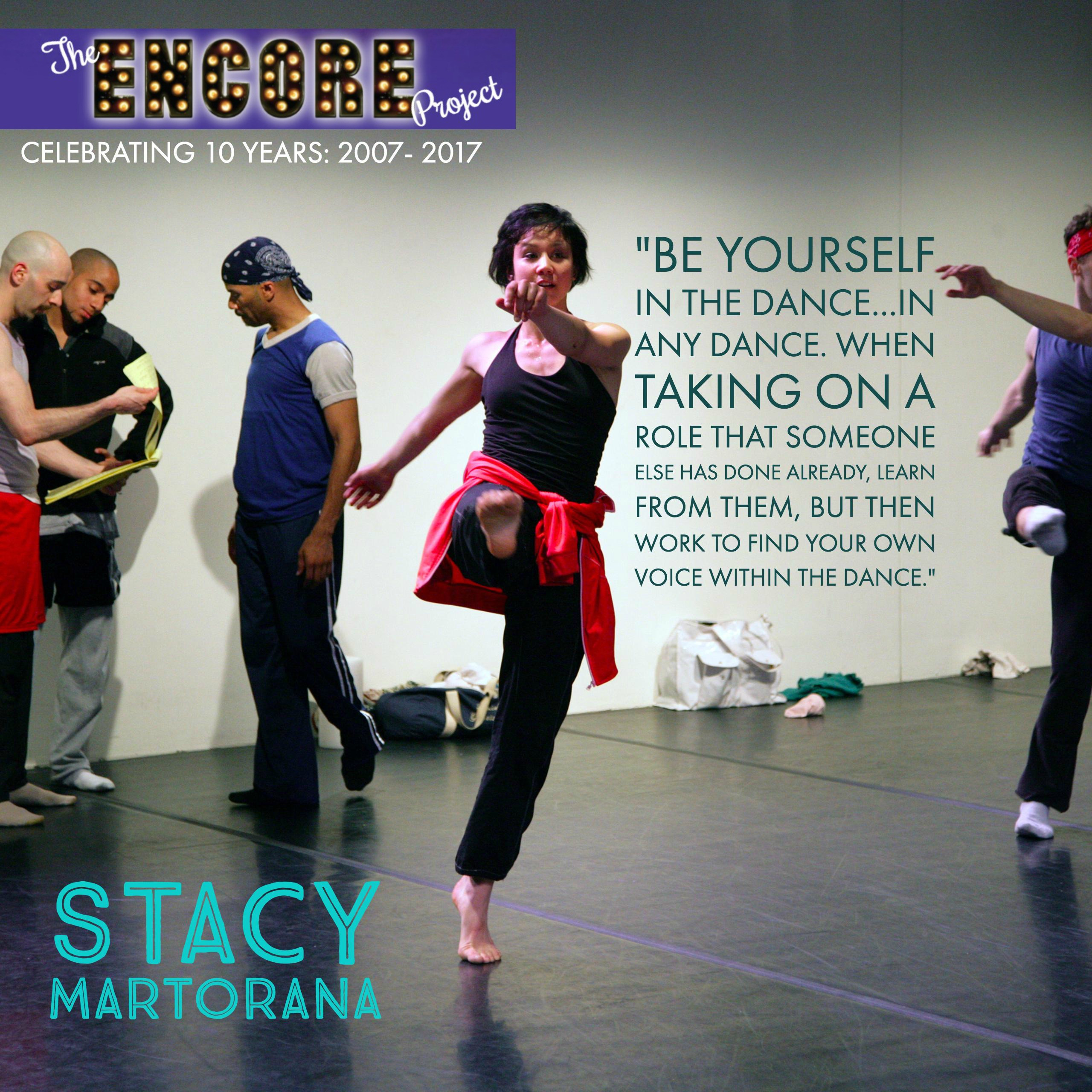 Stacy Martorana, Original Encore Dancer, Burrito Connoisseur
Stacy Martorana, Original Encore Dancer, Burrito Connoisseur
Stacy’s Reflections:
- Creative Process: She found Danny’s work challenging at first due to its speed and intricate musicality. She gradually adapted and felt like she was truly dancing.
- Advice to Dancers: Stacy advises dancers to be themselves and find their own voice within the dance, rather than trying to imitate others.
- Current Activities: Stacy retired from the Mark Morris Dance Group in January 2017 and now teaches Yoga at Tangerine Hot Power Yoga and Crunch.
- Professional Goal: She aims to discover new passions outside of dance and is considering opening her own Yoga studio.
Additional Insights:
- Stacy’s journey highlights the physical and mental challenges of professional dance and the importance of adapting to different styles.
- Her transition to yoga reflects a commitment to health and wellness and a desire to share her knowledge with others.
1.5. Michael Novak: Combining Dance with Business Acumen
Michael Novak fondly remembers rehearsing “Harlem Congo” and “In the Good Ol’ Summertime” with Madeline Hoak and overcoming a severe bronchial infection during the premiere of “Encore.”
 Michael Novak, Original Encore Dancer, Wine Connoisseur
Michael Novak, Original Encore Dancer, Wine Connoisseur
Michael’s Reflections:
- Advice to Dancers: Michael advises dancers to prioritize jobs that offer great experience, pay, and people, aiming for roles that provide at least two of these qualities.
- Current Activities: He is pursuing an MBA and aims to work for both for-profit and non-for-profit organizations in strategic marketing and consumer engagement.
- Guilty Pleasure: Michael is a wine enthusiast and takes wine classes throughout the city.
- Favorite Dance Movie: “Singin’ in the Rain.”
Additional Insights:
- Michael’s pursuit of an MBA demonstrates the diverse skills and interests of dancers and their ability to excel in different fields.
- His involvement with the Paul Taylor Dance Company’s young patron group and the Broadway Dance Lab reflects his continued commitment to the arts.
1.6. Jamie Scott: A Career Bridging Dance and Occupational Therapy
Jamie Scott cherishes her time in the studio with Danny during the creation of “Encore,” particularly the opening sequence of dances known as “The Rehearsal.”
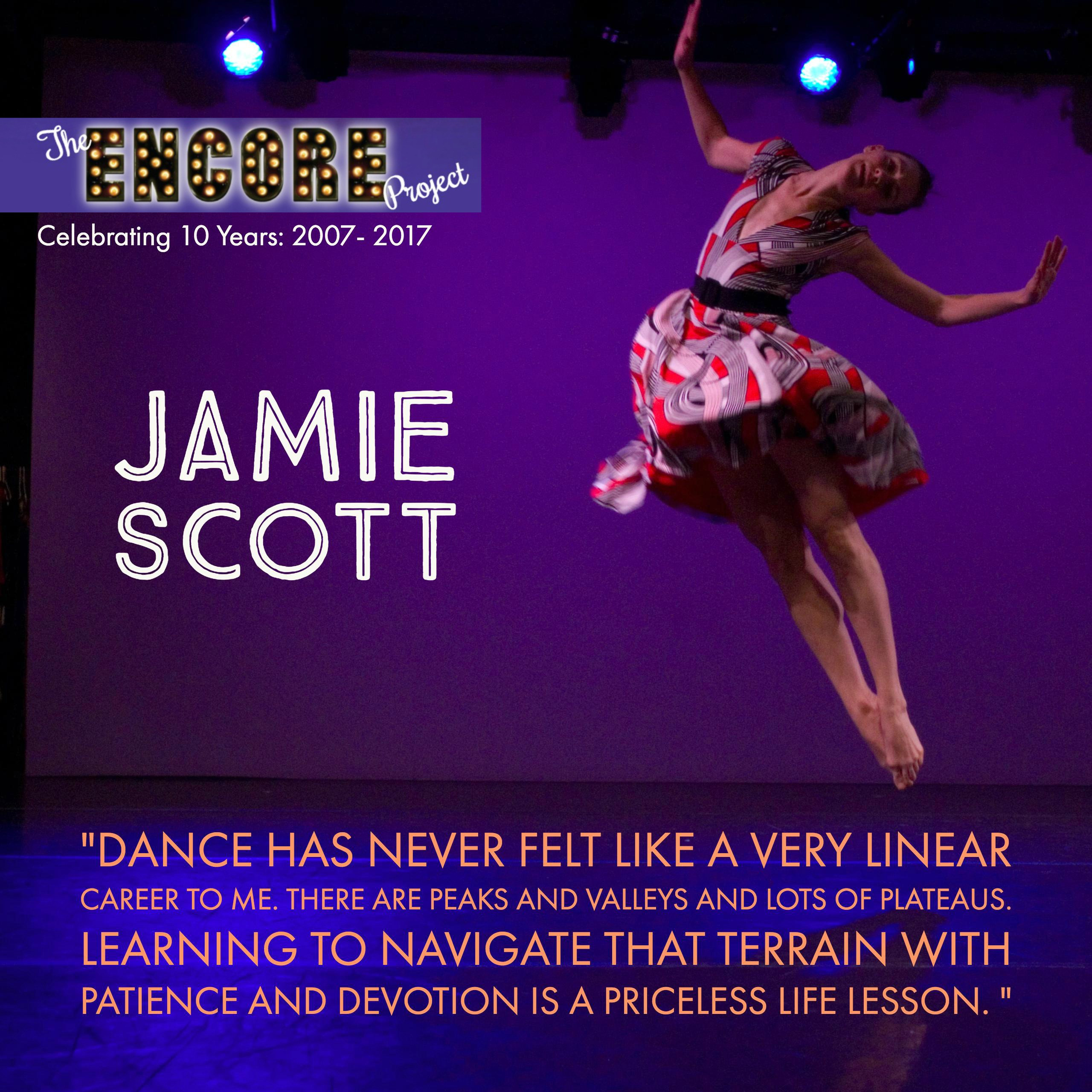 Jamie Scott, Original Encore Dancer, Taco Lover
Jamie Scott, Original Encore Dancer, Taco Lover
Jamie’s Reflections:
- Favorite Memory: She recalls the challenge and excitement of mastering the “King Porter Stomp” and the camaraderie with the cast.
- Advice to Dancers: Jamie emphasizes the non-linear nature of a dance career and the importance of patience and devotion.
- Current Activities: She is pursuing a Masters in Occupational Therapy and continues to teach for the Trisha Brown Dance Company and the Merce Cunningham Trust.
- Favorite Dance Movie: “Singin’ in the Rain.”
Additional Insights:
- Jamie’s pursuit of occupational therapy reflects a desire to translate her movement expertise into a practice that helps others improve their daily lives.
- Her continued involvement with renowned dance companies underscores her enduring passion for performance and education.
1.7. Jessica Vokoun: From “Encore” to Academia
Jessica Vokoun feels fortunate to have been part of the initial creative process of “Encore” at The University of Wisconsin-Milwaukee.
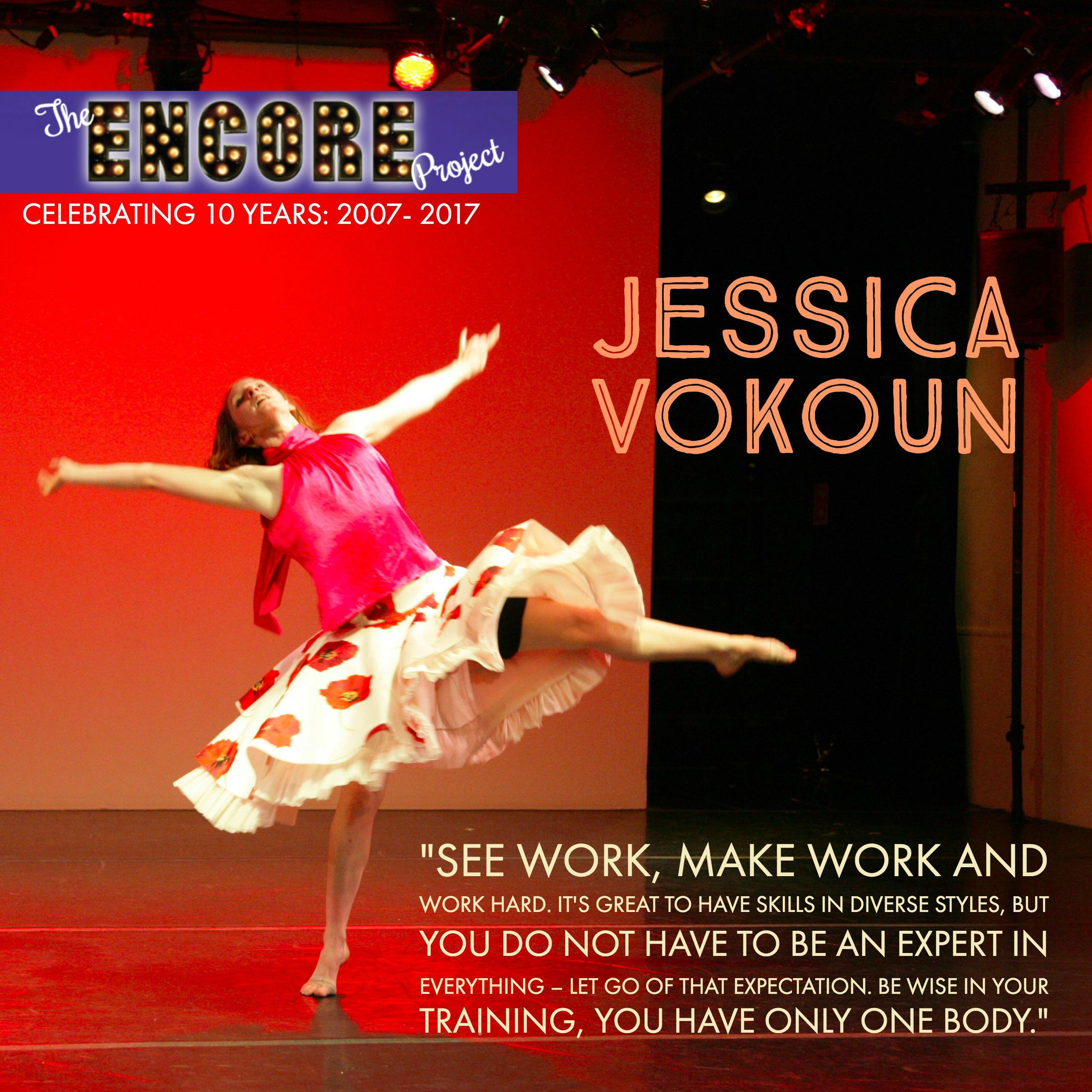 Jessica Vokoun, Original Encore Dancer, Keeps White Cheddar Popcorn In Her Dance Bag
Jessica Vokoun, Original Encore Dancer, Keeps White Cheddar Popcorn In Her Dance Bag
Jessica’s Reflections:
- Creative Process: She enjoyed creating the duet “Ain’t She Sweet” and the ensemble finale “Indiana,” fueled by the music and Danny’s charisma.
- Advice to Dancers: Jessica advises dancers to “See work, make work and work hard,” emphasizing the importance of continuous learning, choreography practice, and diverse training.
- Current Activities: She is an Associate Professor of Dance at the University of Tulsa.
- Favorite Dance Movie: “Strictly Ballroom.”
Additional Insights:
- Jessica’s academic career demonstrates the value of dance education and the opportunity to mentor future generations of dancers.
- Her emphasis on diverse training and continuous learning underscores the importance of adaptability and resilience in the dance world.
The diverse paths of the original “Encore” dancers illustrate the many possibilities that a career in dance can offer. From performing on renowned stages to teaching and choreographing, each dancer has made a unique contribution to the world of dance and beyond. Visit ten-dance.com for more inspiring stories and insights into the dance community.
2. What Are the Key Themes Explored in the Movie “A Time to Dance”?
“A Time to Dance” explores several key themes, including passion, dedication, overcoming obstacles, and the transformative power of dance. These themes resonate deeply with audiences, offering both inspiration and emotional connection.
2.1. Passion and Dedication
The film portrays the intense passion and unwavering dedication required to pursue a career in dance.
- Endless Hours of Training: Dancers spend countless hours honing their skills, pushing their bodies and minds to the limit.
- Sacrifice and Commitment: They often sacrifice personal relationships, financial stability, and other opportunities to pursue their dreams.
- Love for the Art: Their love for dance fuels their determination and helps them overcome challenges.
According to a study by the American Psychological Association, individuals who are passionate about their pursuits are more likely to persevere through difficulties and achieve their goals.
2.2. Overcoming Obstacles
The characters in “A Time to Dance” face various obstacles, including injuries, self-doubt, and external pressures.
- Physical Challenges: Dancers must overcome physical limitations and injuries, requiring resilience and adaptability.
- Emotional Struggles: They grapple with self-doubt, competition, and the pressure to succeed.
- External Barriers: They may face financial constraints, lack of support, or discrimination.
Research from the University of California, Berkeley, suggests that individuals who develop coping mechanisms and maintain a positive mindset are better equipped to overcome obstacles and achieve success.
2.3. Transformative Power of Dance
Dance is portrayed as a transformative force that can heal, inspire, and empower individuals.
- Emotional Expression: Dance provides an outlet for expressing emotions and experiences that may be difficult to articulate verbally.
- Personal Growth: It fosters self-confidence, discipline, and a sense of accomplishment.
- Community Building: Dance brings people together, creating a supportive and collaborative environment.
A study by the National Endowment for the Arts found that participation in arts activities, including dance, is associated with improved mental and physical health, as well as increased civic engagement.
2.4. The Importance of Mentorship
The film highlights the crucial role of mentors in guiding and supporting young dancers.
- Providing Guidance: Mentors offer advice, encouragement, and constructive criticism.
- Sharing Expertise: They share their knowledge and experience, helping dancers develop their skills and navigate the challenges of the dance world.
- Inspiring Confidence: Mentors instill confidence and help dancers believe in their potential.
According to research from Harvard Business School, individuals who have mentors are more likely to advance in their careers and achieve greater success.
“A Time to Dance” captures the essence of these themes, offering a compelling narrative that resonates with audiences of all backgrounds. Visit ten-dance.com for more insights into the world of dance and the stories that inspire us.
3. How Does “A Time to Dance” Movie Portray the Realities of a Dance Career?
“A Time to Dance” offers a glimpse into the demanding and often challenging realities of pursuing a dance career. While it showcases the passion and artistry, it also acknowledges the hard work, sacrifices, and uncertainties that come with it.
3.1. Rigorous Training and Physical Demands
The movie accurately depicts the rigorous training regimen that dancers endure.
- Daily Classes and Rehearsals: Dancers spend hours each day in classes and rehearsals, honing their technique and learning new choreography.
- Physical Strain and Injuries: The intense physical demands can lead to injuries, requiring dancers to prioritize self-care and injury prevention.
- Discipline and Dedication: Dancers must maintain a high level of discipline and dedication to meet the physical challenges of their profession.
According to the American Academy of Orthopaedic Surgeons, dancers are at a higher risk of certain injuries due to the repetitive and high-impact nature of their movements.
3.2. Competition and Auditions
The film realistically portrays the competitive nature of the dance world.
- Constant Auditions: Dancers face constant auditions for roles, requiring them to develop resilience and a thick skin.
- Limited Opportunities: The number of available jobs is often limited, leading to intense competition among dancers.
- Subjectivity and Rejection: Auditions are often subjective, and dancers must learn to cope with rejection and continue to pursue their goals.
Research from the Juilliard School indicates that only a small percentage of aspiring dancers secure professional positions, highlighting the competitive nature of the field.
3.3. Financial Instability
“A Time to Dance” acknowledges the financial challenges that many dancers face.
- Low Salaries: Dancers often earn low salaries, especially early in their careers.
- Part-Time Work: Many dancers supplement their income with part-time jobs or teaching positions.
- Financial Sacrifices: They may need to make financial sacrifices to pursue their passion.
According to a report by the Dance/USA, the median income for professional dancers is significantly lower than the national average, underscoring the financial challenges of the profession.
3.4. Emotional and Mental Health
The film touches on the emotional and mental health challenges that dancers may experience.
- Stress and Anxiety: Dancers may experience stress and anxiety due to the pressure to perform, the uncertainty of their careers, and the physical demands of their work.
- Body Image Issues: They may struggle with body image issues due to the emphasis on appearance in the dance world.
- Burnout and Exhaustion: Dancers may experience burnout and exhaustion due to the intense physical and emotional demands of their profession.
Research from the National Institutes of Health suggests that dancers are at a higher risk of certain mental health issues, such as anxiety and depression, due to the unique stressors of their profession.
3.5. The Rewards of a Dance Career
Despite the challenges, “A Time to Dance” also highlights the rewards of a dance career.
- Artistic Expression: Dance provides an opportunity for artistic expression and creativity.
- Personal Fulfillment: It offers a sense of personal fulfillment and accomplishment.
- Connection with Audiences: Dancers can connect with audiences on an emotional level, sharing their stories and inspiring others.
“A Time to Dance” provides a balanced portrayal of the realities of a dance career, acknowledging both the challenges and the rewards. Visit ten-dance.com for more insights into the dance world and the lives of dancers.
4. What Kind of Dance Styles Are Showcased in “A Time to Dance” Movie?
“A Time to Dance” showcases a variety of dance styles, reflecting the diversity and richness of the dance world. The film incorporates both classical and contemporary forms, highlighting the unique characteristics of each style.
4.1. Ballet
Ballet is a central element in “A Time to Dance,” representing the foundation of many dance careers.
- Classical Technique: The film features classical ballet technique, including precise movements, elegant lines, and graceful port de bras.
- Pointe Work: Dancers showcase their pointe work, demonstrating strength, balance, and artistry.
- Pas de Deux: The film includes pas de deux sequences, highlighting the partnership and coordination between dancers.
According to the Royal Academy of Dance, ballet is a highly disciplined art form that requires years of training to master.
4.2. Modern Dance
Modern dance is also prominently featured, offering a contrast to the structure of ballet.
- Expressive Movement: The film incorporates expressive movements, allowing dancers to explore their emotions and interpretations.
- Floor Work: Dancers utilize floor work, incorporating rolls, falls, and other movements close to the ground.
- Improvisation: The film may include improvisational elements, showcasing dancers’ creativity and spontaneity.
The Martha Graham Dance Company describes modern dance as a form of rebellion against the constraints of classical ballet, emphasizing freedom of expression and individual interpretation.
4.3. Contemporary Dance
Contemporary dance blends elements of ballet and modern dance, creating a versatile and dynamic style.
- Fluid Transitions: The film features fluid transitions between movements, showcasing dancers’ adaptability and control.
- Acrobatic Elements: Contemporary dance may incorporate acrobatic elements, such as jumps, turns, and balances.
- Innovative Choreography: The film may include innovative choreography that pushes the boundaries of traditional dance forms.
The Alvin Ailey American Dance Theater is known for its contemporary works that blend elements of ballet, modern dance, and African dance, creating a unique and powerful style.
4.4. Jazz Dance
Jazz dance adds a lively and energetic dimension to “A Time to Dance.”
- Rhythmic Movement: The film features rhythmic movements, emphasizing syncopation and improvisation.
- Sharp Lines and Isolations: Dancers showcase sharp lines and isolations, creating a dynamic and visually engaging style.
- Musicality: Jazz dance emphasizes musicality, with dancers responding to the rhythm and melody of the music.
According to the танцевальная компания Джаз, jazz dance is a vibrant and expressive form that reflects the cultural influences of African American music and dance traditions.
4.5. Hip-Hop Dance
Hip-hop dance may be incorporated to showcase the diversity of dance styles and cultural influences.
- Street Style: The film may feature street-style movements, such as breaking, locking, and popping.
- Freestyle: Dancers may engage in freestyle, showcasing their individual skills and creativity.
- Social Commentary: Hip-hop dance can be used as a form of social commentary, addressing issues of identity, community, and social justice.
The Rock Steady Crew is a pioneering hip-hop dance crew that has played a significant role in popularizing and promoting the art form worldwide.
“A Time to Dance” celebrates the diversity of dance styles, showcasing the unique characteristics and artistry of each form. Visit ten-dance.com for more information about these dance styles and the dancers who bring them to life.
5. What Is the Significance of the Movie’s Title, “A Time to Dance”?
The title “A Time to Dance” carries significant meaning, reflecting the themes and messages of the film. It suggests a celebration of dance as a powerful and transformative force, as well as a call to embrace joy, expression, and connection.
5.1. Celebration of Dance
The title directly celebrates dance as an art form and a way of life.
- Emphasis on Movement: “Dance” highlights the importance of movement as a means of expression, communication, and personal growth.
- Appreciation of Artistry: The title acknowledges the skill, dedication, and artistry of dancers.
- Recognition of Cultural Significance: It recognizes the cultural significance of dance in various communities and traditions.
The Dance Heritage Coalition is dedicated to preserving and promoting the cultural heritage of dance in the United States, underscoring the importance of dance as a valuable art form.
5.2. Embracing Joy and Expression
“A Time to Dance” suggests a call to embrace joy and expression through dance.
- Freedom of Movement: The title encourages individuals to express themselves freely through movement, regardless of their skill level or background.
- Release of Emotions: It suggests that dance can be a cathartic outlet for releasing emotions and experiences.
- Celebration of Life: The title celebrates the joy and vitality of life through dance.
The American Dance Therapy Association promotes the use of dance as a therapeutic tool for improving mental, emotional, and physical well-being, highlighting the power of dance to heal and transform.
5.3. Connection and Community
The title implies a sense of connection and community through dance.
- Shared Experience: “A Time to Dance” suggests that dance can bring people together, creating a shared experience that transcends cultural and linguistic barriers.
- Collaboration and Partnership: The title acknowledges the importance of collaboration and partnership in dance, as dancers work together to create and perform.
- Supportive Environment: It implies a supportive environment where dancers can learn, grow, and inspire each other.
The International Dance Council (CID) is the official organization for all forms of dance recognized by UNESCO, promoting international cooperation and collaboration in the dance world.
5.4. Overcoming Adversity
The title can also be interpreted as a call to dance even in the face of adversity.
- Resilience and Strength: “A Time to Dance” suggests that dance can provide resilience and strength in challenging times.
- Hope and Inspiration: The title offers hope and inspiration, encouraging individuals to find joy and meaning through dance, even when faced with difficulties.
- Triumph of the Human Spirit: It celebrates the triumph of the human spirit through art and movement.
The organization Dancers Without Borders uses dance as a tool for social change, working with communities affected by conflict and displacement to promote healing and reconciliation.
“A Time to Dance” is a powerful and evocative title that captures the essence of the film’s themes and messages. Visit ten-dance.com for more inspiration and insights into the world of dance.
6. How Did the Choreography in “A Time to Dance” Movie Enhance the Storytelling?
The choreography in “A Time to Dance” plays a crucial role in enhancing the storytelling, conveying emotions, developing characters, and advancing the plot.
6.1. Expressing Emotions
The choreography effectively expresses the emotions of the characters.
- Movement as Language: The movements are used as a language to communicate feelings that may be difficult to articulate verbally.
- Emotional Range: The choreography captures a wide range of emotions, from joy and love to sadness and anger.
- Subtlety and Nuance: The choreography conveys subtle nuances of emotion, adding depth and complexity to the characters.
According to исследования от ученых, dance is a powerful tool for expressing emotions, allowing individuals to connect with their feelings and communicate them to others.
6.2. Developing Characters
The choreography helps to develop the characters and reveal their personalities.
- Individual Styles: Each character may have a unique dance style that reflects their personality and background.
- Relationships and Interactions: The choreography can illustrate the relationships and interactions between characters, highlighting their connections and conflicts.
- Character Growth: The choreography can show character growth and transformation over time, as dancers evolve and develop their skills.
Research from the University of Roehampton suggests that dance can be used as a tool for self-discovery and personal development, helping individuals to understand themselves better and express their unique identities.
6.3. Advancing the Plot
The choreography advances the plot and moves the story forward.
- Key Events: The choreography can be used to depict key events in the story, such as auditions, performances, and competitions.
- Symbolic Representation: The movements can be used as symbolic representations of themes and ideas, adding layers of meaning to the narrative.
- Climax and Resolution: The choreography can build towards a climax and resolution, providing a satisfying conclusion to the story.
The Dance Films Association promotes the creation and appreciation of dance films, recognizing the power of choreography to enhance storytelling and create compelling cinematic experiences.
6.4. Creating Atmosphere and Mood
The choreography contributes to the overall atmosphere and mood of the film.
- Visual Spectacle: The choreography can create a visual spectacle, engaging the audience and drawing them into the world of the story.
- Emotional Impact: The choreography can evoke strong emotions in the audience, enhancing their connection to the characters and the story.
- Artistic Expression: The choreography adds an artistic dimension to the film, elevating it beyond a simple narrative and creating a work of art.
The Jacob’s Pillow Dance Festival celebrates the art of dance, showcasing a diverse range of choreographers and performers and recognizing the power of dance to inspire and transform.
“A Time to Dance” demonstrates the power of choreography to enhance storytelling, adding depth, emotion, and artistry to the film. Visit ten-dance.com for more insights into the creative process and the role of dance in film.
7. Where Was “A Time to Dance” Movie Filmed and How Did the Locations Contribute to the Story?
The filming locations for “A Time to Dance” likely played a significant role in enhancing the visual appeal and authenticity of the story, contributing to the overall atmosphere and mood of the film. While specific details about the exact locations may vary, here are some potential locations and how they might have contributed:
7.1. Dance Studios
Dance studios would have been essential locations for filming rehearsals and training sessions.
- Authenticity: Using real dance studios would have added authenticity to the film, capturing the atmosphere and energy of these spaces.
- Visual Appeal: The studios could have been chosen for their visual appeal, with high ceilings, large windows, and sprung floors providing a dynamic backdrop for the dance sequences.
- Character Development: The studios could have served as a setting for character development, showing the dancers’ dedication, discipline, and camaraderie.
Many dance films, such as “Black Swan” and “Center Stage,” utilize dance studios as primary filming locations to capture the essence of the dance world.
7.2. Theaters and Performance Venues
Theaters and performance venues would have been crucial for filming performance scenes and competitions.
- Grandeur and Scale: Using grand theaters would have added a sense of grandeur and scale to the film, showcasing the culmination of the dancers’ hard work and dedication.
- Emotional Impact: The theaters could have been chosen for their emotional impact, with dramatic lighting, ornate architecture, and a sense of history contributing to the atmosphere.
- Climax and Resolution: The theaters could have served as a setting for the climax and resolution of the story, as the dancers perform and achieve their goals.
Films like “Step Up” and “Save the Last Dance” feature performance venues as key locations, highlighting the excitement and energy of live dance performances.
7.3. Urban Landscapes
Urban landscapes may have been used to provide a contrast to the structured world of dance, showcasing the dancers’ lives outside of the studio.
- Realism and Authenticity: Using real urban locations would have added realism and authenticity to the film, capturing the grit and energy of city life.
- Character Background: The urban landscapes could have provided context for the characters’ backgrounds, showing their struggles, dreams, and aspirations.
- Visual Contrast: The urban landscapes could have created a visual contrast to the dance studios and theaters, highlighting the different facets of the dancers’ lives.
Films like “Fame” and “Honey” utilize urban landscapes to showcase the dancers’ lives and communities, adding a layer of social commentary to the story.
7.4. Natural Settings
Natural settings, such as parks, beaches, or forests, may have been used to provide a sense of freedom and escape.
- Symbolic Representation: Natural settings could have been used as symbolic representations of themes and ideas, such as freedom, growth, and transformation.
- Visual Beauty: The natural settings could have added visual beauty to the film, providing a respite from the intensity of the dance world.
- Character Reflection: The natural settings could have served as a space for character reflection, allowing the dancers to connect with their emotions and find inspiration.
Films like “Dirty Dancing” and “Footloose” utilize natural settings to enhance the emotional impact of the story and provide a sense of freedom and escape.
The filming locations for “A Time to Dance” would have played a significant role in enhancing the story, adding visual appeal, authenticity, and emotional depth to the film. Visit ten-dance.com for more insights into the making of dance films and the power of location to enhance storytelling.
8. What Costumes Were Used in “A Time to Dance” and What Impact Did They Have?
The costumes in “A Time to Dance” would have been carefully chosen to enhance the visual appeal of the film, reflect the characters’ personalities, and support the storytelling.
8.1. Ballet Costumes
Ballet costumes would have been used to emphasize the elegance and grace of the ballet sequences.
- Tutus: Tutus, both classical and romantic, would have been used to create a sense of lightness and ethereal beauty.
- Leotards and Tights: Leotards and tights would have been used to showcase the dancers’ lines and technique.
- Color Palette: The color palette would have been chosen to reflect the mood and tone of the ballet sequences, with soft pastels and classic whites often used.
The Royal Ballet is renowned for its exquisite ballet costumes, which enhance the visual impact of its performances and reflect the traditions of classical ballet.
8.2. Modern Dance Costumes
Modern dance costumes would have been used to emphasize freedom of movement and emotional expression.
- Flowing Fabrics: Flowing fabrics, such as chiffon and silk, would have been used to create a sense of fluidity and dynamism.
- Asymmetrical Designs: Asymmetrical designs would have been used to reflect the unconventional nature of modern dance.
- Neutral Colors: Neutral colors, such as blacks, grays, and earth tones, would have been used to emphasize the dancers’ movements and emotions.
The Martha Graham Dance Company is known for its innovative modern dance costumes, which reflect the company’s commitment to pushing the boundaries of dance and design.
8.3. Contemporary Dance Costumes
Contemporary dance costumes would have blended elements of ballet and modern dance, creating a versatile and dynamic style.
- Form-Fitting Designs: Form-fitting designs would have been used to showcase the dancers’ athleticism and control.
- Unconventional Materials: Unconventional materials, such as mesh and Lycra, would have been used to create a modern and edgy look.
- Bold Colors and Patterns: Bold colors and patterns would have been used to add visual interest and energy to the contemporary dance sequences.
The Alvin Ailey American Dance Theater is celebrated for its contemporary dance costumes, which reflect the company’s diverse repertoire and its commitment to artistic innovation.
8.4. Jazz Dance Costumes
Jazz dance costumes would have been used to emphasize rhythm, energy, and style.
- Sequins and Sparkle: Sequins and sparkle would have been used to create a sense of glamour and excitement.
- Fringe and Tassels: Fringe and tassels would have been used to add movement and texture to the costumes.
- Bold Colors and Patterns: Bold colors and patterns would have been used to reflect the vibrancy and energy of jazz dance.
The танцевальная компания Джаз is known for its stylish and energetic jazz dance costumes, which reflect the company’s commitment to celebrating the traditions of jazz dance.
8.5. Hip-Hop Dance Costumes
Hip-hop dance costumes would have been used to reflect street style, individuality, and cultural identity.
- Loose-Fitting Clothing: Loose-fitting clothing, such as baggy pants and oversized t-shirts, would have been used to allow for freedom of movement.
- Sneakers and Accessories: Sneakers and accessories, such as hats, bandanas, and jewelry, would have been used to add personal style and flair.
- Bold Colors and Graphics: Bold colors and graphics would have been used to reflect the energy and attitude of hip-hop culture.
The Rock Steady Crew is known for its iconic hip-hop dance style and its distinctive costumes, which reflect the crew’s commitment to preserving and promoting hip-hop culture.
The costumes in “A Time to Dance” would have played a significant role in enhancing the visual appeal of the film, reflecting the characters’ personalities, and supporting the storytelling. Visit ten-dance.com for more insights into the world of dance and the power of costume design.
9. What Music Was Featured in “A Time to Dance” Movie and What Effect Did It Have?
The music featured in “A Time to Dance” would have been carefully selected to enhance the emotional impact of the film, support the storytelling, and reflect the diversity of dance styles.
9.1. Classical Music
Classical music would have been used to accompany the ballet sequences, emphasizing elegance and grace.
- Iconic Composers: Works by iconic composers such as Tchaikovsky, Bach, and Mozart would have been used to create a sense of timeless beauty and sophistication.
- Emotional Impact: The classical music would have enhanced the emotional impact of the ballet sequences, heightening the drama, romance, and passion.
- Historical Context: The classical music would have provided a historical context for the ballet sequences, connecting them to the traditions of classical dance.
The New York City Ballet is renowned for its use of classical music, which enhances the beauty and artistry of its performances and reflects the traditions of classical ballet.
9.2. Contemporary Music
Contemporary music would have been used to accompany the modern and contemporary dance sequences, emphasizing innovation and emotional expression.
- Eclectic Mix: An eclectic mix of contemporary genres, such as electronic, ambient, and alternative, would have been used to create a modern and edgy sound.
- Emotional Depth: The contemporary music would have added emotional depth to the modern and contemporary dance sequences, reflecting the characters’ inner struggles and triumphs.
- Breaking Boundaries: The contemporary music would have reflected the boundary-breaking nature of modern and contemporary dance, pushing the limits of tradition and convention.
The Alvin Ailey American Dance Theater is known for its use of contemporary music, which reflects the company’s commitment to artistic innovation and its exploration of diverse cultural influences.
9.3. Jazz Music
Jazz music would have been used to accompany the jazz dance sequences, emphasizing rhythm, energy, and improvisation.
- Classic Standards: Classic jazz standards by artists such as Duke Ellington, Count Basie, and Ella Fitzgerald would have been used to create a sense of nostalgia and tradition.
- Improvisational Elements: The improvisational elements of jazz music would have mirrored the improvisational nature of jazz dance, allowing for spontaneity and creativity.
- Celebratory Vibe: The jazz music would have created a celebratory vibe, reflecting the joy and energy of jazz dance.
The танцевальная компания Джаз is celebrated for its use of jazz music, which enhances the company’s performances and reflects its commitment to preserving and promoting the traditions of jazz dance.
9.4. Pop Music
Pop music may have been used to accompany the hip-hop and street dance sequences, emphasizing energy and accessibility.
- Upbeat Rhythms: Upbeat rhythms and catchy melodies would have been used to create a sense of excitement and fun.
- Commercial Appeal: The commercial appeal of pop music would have made the hip-hop and street dance sequences more accessible to a wider audience.
- Contemporary Relevance: The use of contemporary pop music would have given the film a sense of relevance and connection to current trends.
Films like “Step Up” and “Honey” feature pop music prominently, enhancing the energy and excitement of the dance sequences and appealing to a wide audience.
The music featured in “A Time to Dance” would have played a significant role in enhancing the emotional impact of the film, supporting the storytelling, and reflecting the diversity of dance styles. Visit ten-dance.com for more insights into the role of music in dance and the power of sound to enhance visual art.
